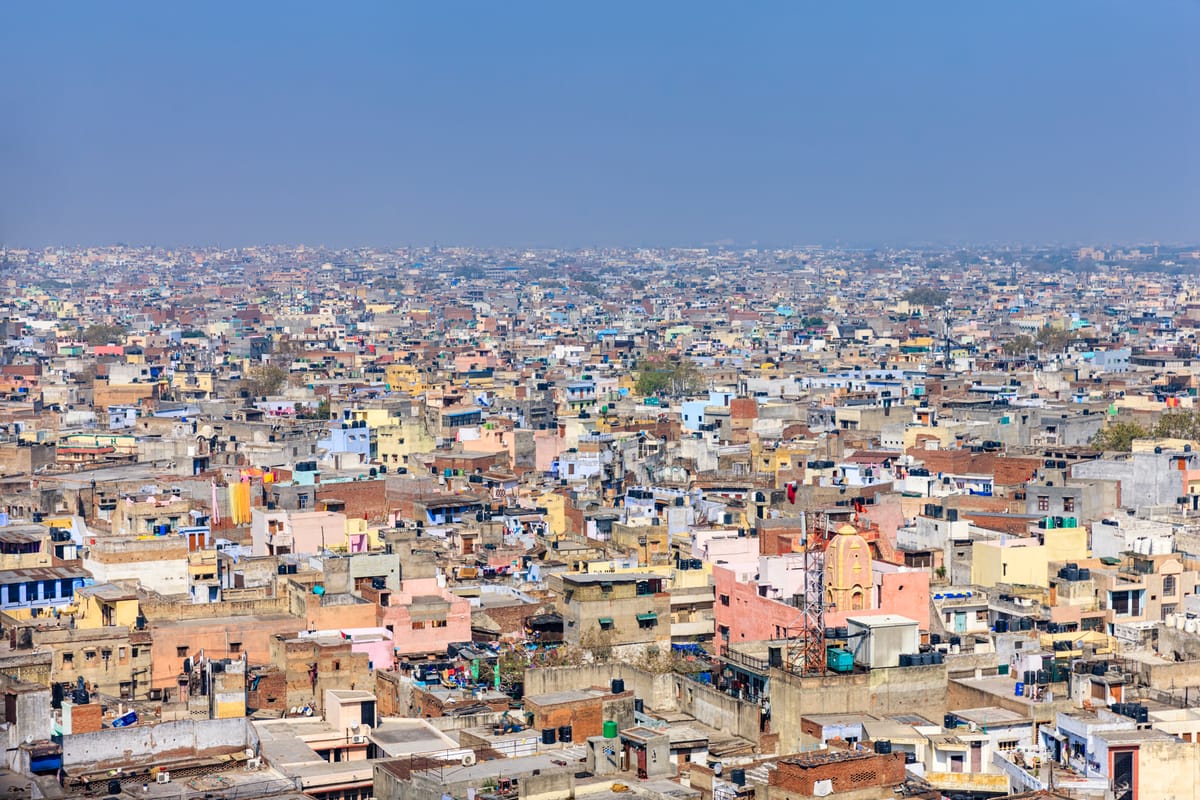The World’s Most Fragile Cities: 2025 Global Fragility Ranking
GINC’s 2025 Global Fragility Ranking reveals the cities most at risk worldwide—highlighting urban centers where economic, environmental, and governance pressures converge to threaten stability and resilience.

Key Findings from the 2025 Ranking
- Gaza City ranks as the most fragile urban environment globally, scoring the maximum or near-maximum across all five indicators following the catastrophic war of 2024–2025.
- Port-au-Prince, Khartoum, and Sana’a also rank near the top due to complete or near-complete collapse of state functions, security, and economic life.
- Several cities—Caracas, Beirut, Karachi, and Dhaka—score high despite not being in warzones, highlighting fragility linked to economic implosion, governance breakdown, and climate exposure.
- Some cities traditionally considered “conflict-affected” (e.g. Kabul, Damascus) show marginal improvements in security but remain highly fragile due to persistent governance and economic challenges.
- Cities like Tijuana and Cox’s Bazar illustrate how extreme violence or displacement can occur in middle-income or developing economies with otherwise functional national governments.
| # | City | Pop | Score | Secy | Govn | Econ | Socl | Envr |
|---|---|---|---|---|---|---|---|---|
| 1 | 🇵🇸 Gaza City | 0.8M | 9.4 | 10.0 | 9.0 | 10.0 | 10.0 | 8.0 |
| 2 | 🇭🇹 Port-au-Prince | 1.2M | 9.2 | 9.0 | 10.0 | 8.5 | 9.5 | 9.0 |
| 3 | 🇸🇩 Khartoum | 6.0M | 9.1 | 10.0 | 10.0 | 9.5 | 9.5 | 6.5 |
| 4 | 🇾🇪 Sana’a | 3.0M | 9.0 | 8.5 | 9.0 | 9.5 | 10.0 | 8.0 |
| 5 | 🇸🇴 Mogadishu | 2.5M | 8.5 | 9.5 | 9.0 | 8.0 | 9.0 | 7.0 |
| 6 | 🇸🇸 Juba | 0.6M | 8.3 | 7.0 | 9.0 | 8.5 | 9.0 | 8.0 |
| 7 | 🇦🇫 Kabul | 4.5M | 8.2 | 8.0 | 8.0 | 9.0 | 8.5 | 7.5 |
| 8 | 🇸🇾 Damascus | 2.3M | 7.8 | 7.0 | 8.0 | 9.0 | 9.0 | 6.0 |
| 9 | 🇻🇪 Caracas | 2.9M | 7.8 | 8.0 | 7.0 | 9.5 | 9.0 | 5.5 |
| 10 | 🇲🇲 Yangon | 5.1M | 7.6 | 7.0 | 8.5 | 8.0 | 8.0 | 6.5 |
| 11 | 🇱🇧 Beirut | 2.4M | 7.6 | 5.0 | 9.0 | 10.0 | 8.0 | 6.0 |
| 12 | 🇨🇫 Bangui | 0.9M | 7.7 | 7.5 | 9.0 | 8.0 | 8.0 | 6.0 |
| 13 | 🇲🇱 Bamako | 2.8M | 7.0 | 6.0 | 8.0 | 7.0 | 7.0 | 7.0 |
| 14 | 🇳🇬 Maiduguri | 1.2M | 7.0 | 7.5 | 6.0 | 7.0 | 7.5 | 7.0 |
| 15 | 🇵🇰 Karachi | 16.5M | 7.0 | 6.0 | 7.0 | 7.0 | 7.0 | 8.0 |
| 16 | 🇱🇾 Tripoli | 1.1M | 6.8 | 7.0 | 8.0 | 7.0 | 7.0 | 5.0 |
| 17 | 🇭🇳 Tegucigalpa | 1.2M | 6.8 | 7.0 | 6.0 | 6.0 | 7.0 | 8.0 |
| 18 | 🇧🇩 Cox’s Bazar | 0.3M | 6.6 | 4.0 | 5.0 | 7.0 | 9.0 | 8.0 |
| 19 | 🇧🇩 Dhaka | 22.5M | 6.4 | 5.0 | 5.0 | 6.0 | 7.0 | 9.0 |
| 20 | 🇲🇽 Tijuana | 2.2M | 6.4 | 10.0 | 5.0 | 6.0 | 6.0 | 5.0 |
| 21 | 🇨🇲 Douala | 2.3M | 6.9 | 7.5 | 6.5 | 7.0 | 6.9 | 6.7 |
| 22 | 🇺🇬 Kampala | 3.0M | 6.8 | 6.8 | 7.1 | 6.2 | 7.0 | 6.8 |
| 23 | 🇵🇭 Manila | 13.5M | 6.8 | 7.0 | 6.8 | 6.5 | 7.1 | 6.5 |
| 24 | 🇮🇷 Tehran | 8.7M | 6.8 | 6.5 | 7.0 | 6.4 | 6.9 | 7.1 |
| 25 | 🇹🇩 N'Djamena | 1.5M | 6.7 | 7.3 | 6.7 | 6.0 | 6.9 | 6.5 |
| 26 | 🇪🇬 Cairo | 20.5M | 6.7 | 6.0 | 7.1 | 6.3 | 7.2 | 6.7 |
| 27 | 🇿🇼 Harare | 1.6M | 6.7 | 6.9 | 6.2 | 6.5 | 6.8 | 7.0 |
| 28 | 🇷🇺 Vladikavkaz | 0.9M | 6.6 | 6.2 | 6.3 | 6.1 | 6.7 | 7.7 |
| 29 | 🇷🇸 Belgrade | 1.4M | 6.6 | 5.8 | 6.6 | 6.4 | 6.6 | 7.5 |
| 30 | 🇰🇪 Nairobi | 4.4M | 6.6 | 6.0 | 6.7 | 6.4 | 6.6 | 7.3 |
| 31 | 🇧🇷 Fortaleza | 2.7M | 6.5 | 7.1 | 6.3 | 6.1 | 6.5 | 7.0 |
| 32 | 🇨🇴 Medellín | 2.6M | 6.5 | 6.9 | 6.4 | 6.3 | 6.6 | 7.4 |
| 33 | 🇹🇳 Tunis | 2.4M | 6.5 | 6.5 | 6.5 | 6.5 | 6.5 | 6.5 |
| 34 | 🇪🇹 Addis Ababa | 5.0M | 6.5 | 6.8 | 6.2 | 6.1 | 6.9 | 6.5 |
| 35 | 🇧🇴 La Paz | 1.8M | 6.5 | 6.2 | 6.5 | 6.3 | 6.6 | 7.0 |
| 36 | 🇲🇿 Maputo | 1.2M | 6.4 | 6.3 | 6.4 | 6.2 | 6.5 | 7.0 |
| 37 | 🇱🇦 Vientiane | 0.9M | 6.4 | 5.9 | 6.4 | 6.2 | 6.7 | 6.8 |
| 38 | 🇮🇶 Baghdad | 7.1M | 6.4 | 6.4 | 6.1 | 6.1 | 6.8 | 6.7 |
| 39 | 🇨🇳 Urumqi | 4.0M | 6.4 | 6.5 | 6.0 | 6.2 | 6.6 | 7.0 |
| 40 | 🇹🇷 Istanbul | 15.5M | 6.4 | 6.2 | 6.3 | 6.0 | 6.8 | 7.0 |
| 41 | 🇱🇰 Colombo | 0.8M | 6.4 | 5.9 | 6.2 | 6.4 | 6.6 | 7.0 |
| 42 | 🇱🇷 Monrovia | 1.1M | 6.3 | 6.0 | 6.1 | 6.2 | 6.4 | 7.0 |
| 43 | 🇰🇭 Phnom Penh | 2.1M | 6.3 | 6.0 | 6.2 | 6.2 | 6.5 | 6.8 |
| 44 | 🇦🇴 Luanda | 8.3M | 6.3 | 6.0 | 6.3 | 6.0 | 6.4 | 7.0 |
| 45 | 🇦🇱 Tirana | 0.6M | 6.2 | 6.1 | 6.2 | 6.0 | 6.3 | 6.3 |
| 46 | 🇬🇹 Guatemala City | 2.5M | 6.2 | 5.9 | 6.2 | 6.0 | 6.4 | 6.5 |
| 47 | 🇩🇿 Algiers | 3.9M | 6.2 | 5.9 | 6.2 | 6.1 | 6.4 | 6.3 |
| 48 | 🇨🇺 Havana | 2.1M | 6.1 | 5.8 | 6.0 | 6.0 | 6.4 | 6.4 |
| 49 | 🇲🇦 Casablanca | 3.7M | 6.1 | 5.8 | 6.0 | 6.1 | 6.4 | 6.3 |
| 50 | 🇧🇫 Ouagadougou | 2.9M | 6.1 | 5.8 | 6.0 | 6.1 | 6.2 | 6.3 |
What Makes a City Fragile?
Urban fragility refers to the vulnerability of cities to a combination of political, economic, social, and environmental shocks that overwhelm their capacity to respond, adapt, and recover. A fragile city is one where the social contract between governments and citizens is strained or broken—where public institutions are unable to provide safety, deliver basic services, or sustain economic and social stability. These are cities where day-to-day survival is uncertain and long-term resilience is elusive.
In 2025, fragility is no longer confined to war zones. It now includes megacities under strain from environmental disasters, economic collapse, or criminal violence. This year’s Global Fragile Cities Ranking presents a data-informed assessment of 50 cities facing extreme risk. Each city is evaluated across five dimensions: Security & Conflict, Governance & Political Stability, Economic Stability, Social Fragility, and Environmental & Climate Vulnerability. The rankings are based on publicly available data, global crisis monitoring, and expert analysis.
The goal of this index is not to stigmatize these cities but to surface the risks they face, highlight the underlying dynamics of fragility, and inform strategies for recovery and resilience.
Regional Patterns in Urban Fragility
The 2025 Fragile Cities Index reveals distinct regional concentrations of vulnerability, shaped by intersecting factors such as armed conflict, governance failures, economic pressures, and environmental exposure. While fragility is a global phenomenon, the types and drivers of fragility vary significantly across regions, reflecting underlying political and developmental contexts.
Africa: High Fragility Across Conflict and Governance Dimensions
African cities dominate the top 50, accounting for nearly half the list. Cities like Khartoum (Sudan), Mogadishu (Somalia), Juba (South Sudan), Bangui (Central African Republic), and Ouagadougou (Burkina Faso) rank among the most fragile urban areas globally. These cities face extreme political instability, often compounded by armed conflict, weak institutions, and recurring humanitarian crises.
Many African capitals are affected by jihadist insurgencies (e.g., in the Sahel), post-coup governance vacuums, or enduring civil conflict. In Khartoum, for instance, two rival militaries have turned the capital into a battlefield, while cities like Ouagadougou and Bamako continue to struggle with extremist violence and governance breakdown following military takeovers. Social fragility is also acute, with high displacement, food insecurity, and underfunded services across the region. However, environmental vulnerability is a growing second-order threat: climate-driven droughts, floods, and water scarcity increasingly undermine urban resilience.
Latin America: Crime and Economic Breakdown Drive Fragility
Latin American cities in the index tend to score lower on active conflict but face very high levels of criminal violence, inequality, and economic stress. Port-au-Prince (Haiti) stands out for extreme fragility across all dimensions: the state has effectively collapsed, and the city is dominated by armed gangs, leading to soaring displacement and humanitarian need.
Elsewhere, cities like Caracas (Venezuela), Tegucigalpa (Honduras), Medellín (Colombia), Fortaleza (Brazil), and Guatemala City (Guatemala) face economic collapse, hyperinflation, or chronic criminal violence, making them highly fragile despite not being warzones. These cities share a pattern of weak governance, eroded public trust, and deep income inequality. Environmental risks—such as hurricanes and floods—are also rising threats in this region, especially in Central America and the Caribbean. The Latin American profile is one of fragility driven from within: governance erosion, economic stagnation, and social exclusion.
Asia: Conflict Flashpoints and Mega-Urban Stress
In Asia, fragility takes on multiple forms—from active conflict zones to overstretched megacities. Gaza City (Palestine) ranks as the most fragile city globally following the catastrophic war in 2024–2025, with complete collapse of governance, infrastructure, and human security. Kabul (Afghanistan) and Yangon (Myanmar) continue to suffer from civil war and authoritarian repression, with their populations facing both conflict and economic collapse.
Other Asian cities like Dhaka (Bangladesh), Manila (Philippines), and Karachi (Pakistan) reveal a different kind of fragility—massive urban growth outpacing infrastructure, rising inequality, and climate risks such as flooding and heatwaves. These cities may not be war-torn, but their combinations of poor planning, weak service delivery, and vulnerability to environmental stress make them highly fragile. In Central and West Asia, cities like Tehran, Baghdad, and Urumqi score moderately high due to geopolitical volatility, surveillance governance, and economic sanctions.
Middle East and North Africa: From Collapse to Climate Tension
The MENA region features prominently in the top half of the index, with cities like Sana’a (Yemen), Damascus (Syria), Tripoli (Libya), and Beirut (Lebanon) experiencing protracted political collapse, economic meltdown, or proxy conflict. These cities often lack functioning central governments and struggle with basic service delivery, displacement, and social fragmentation.
Beirut and Caracas stand out as “middle-income collapses,” where fragility stems from economic implosion and state failure, not war. Meanwhile, environmental stress is rising sharply in North African cities such as Cairo and Casablanca, where water scarcity, heat, and air pollution intersect with governance strain and urban inequality.
Europe and Central Asia: Peripheral Tensions and Socioeconomic Stress
While most European cities are absent from the top 50, a few entries—Belgrade (Serbia), Tirana (Albania), and Vladikavkaz (Russia)—reflect regional security tensions, governance constraints, and underlying economic fragility. These cities typically score lower on security but higher on economic vulnerability and weak local institutions, particularly in post-conflict or authoritarian contexts.
Vladikavkaz, for instance, lies in a geopolitically sensitive area of the Russian Federation, while Belgrade and Tirana face lingering governance and development challenges despite EU aspirations. Their inclusion reflects a broader insight: fragility is not exclusive to low-income or war-affected areas—it can emerge within transitioning economies with structural weaknesses.
The 2025 Fragile Cities Ranking underscores that urban fragility is not monolithic. In some regions, it is driven by war and state collapse; in others, by violence, inequality, or climate shocks. The drivers differ, but the outcomes—institutional failure, humanitarian need, and eroded resilience—are shared. These regional patterns highlight the need for context-specific strategies that acknowledge the different pathways to fragility and support cities in building tailored forms of resilience.
Evaluating Fragile Cities
To understand what makes a city fragile, the Fragile Cities Index breaks vulnerability down into five core domains. These dimensions reflect the structural and situational pressures that undermine urban resilience—pressures that, if unaddressed, lead to the erosion of public order, social cohesion, and basic human security. While fragility can emerge in many forms, from chronic gang violence to economic collapse or climate disaster, these five domains offer a comprehensive framework to compare cities around the world on a common scale.
Each domain captures a distinct axis of stress: from the threat of violence and political instability to economic precarity, social breakdown, and climate-related risks. Scoring is based on recent data, expert monitoring, and on-the-ground reporting. The following sections explain what each domain measures, why it matters, and how cities were assessed. Together, they reveal the multi-dimensional nature of fragility—and why tackling it requires more than just restoring order. It demands building resilience across all facets of urban life.
Security and Conflict Vulnerability
What it measures: The extent to which violence, insurgency, terrorism, or organized crime threaten life, stability, and rule of law.
Why it matters: Cities cannot function without basic safety. High levels of insecurity erode trust in government, deter investment, and disrupt public life. Fragile cities are often marked by persistent violence—from war zones like Gaza City and Khartoum, to gang-dominated cities like Port-au-Prince or cartel hotspots like Tijuana.
Scoring considerations: Cities were rated based on recent data from conflict tracking platforms (ACLED, UN OCHA), homicide rates, terrorism incidents, and reports of widespread criminal violence. Gaza City, facing a catastrophic war in 2024–2025, scores a full 10.0. Other high-scorers include Khartoum (urban warfare), Mogadishu (insurgency), and Tijuana (highest homicide rate globally).
Governance and Political Stability
What it measures: The ability of local or national institutions to govern effectively, maintain legitimacy, and deliver services without corruption or collapse.
Why it matters: Even amid hardship, strong governance can reduce fragility. Weak, fragmented, or authoritarian governments often fail to manage crises, enforce laws, or meet public expectations. In fragile cities, state presence may be minimal, politicized, or absent entirely.
Scoring considerations: We assessed institutional functionality, legitimacy, political continuity, and presence of parallel power structures (e.g. militias or gangs). Port-au-Prince, where gangs control over 80% of the city, and Khartoum, where state institutions have collapsed under military conflict, scored a maximum 10.0. Beirut and Caracas, despite lower levels of violence, suffer from paralyzed or illegitimate governance, earning high fragility scores.
Economic Stability
What it measures: The city’s ability to sustain livelihoods, ensure basic economic functioning, and recover from shocks.
Why it matters: Economic collapse leads to hunger, unemployment, and social unrest. Cities with stagnant or imploded economies cannot maintain infrastructure, pay civil servants, or attract investment. When prices soar and incomes disappear, fragility spikes.
Scoring considerations: We considered factors such as GDP contraction, inflation, unemployment, dependence on aid, and disruptions to markets. Caracas and Beirut were rated among the most economically fragile, with collapsed banking systems and currency devaluation. In Gaza, the war has rendered 95% of the population aid-dependent. Even cities not in open conflict, like Dhaka, face risks from massive informality and economic overdependence on vulnerable sectors.
Social Fragility
What it measures: Inequality, displacement, service delivery gaps (health, education, housing), and social cohesion breakdown.
Why it matters: Social fragility reflects the human toll of urban dysfunction—rising infant mortality, malnutrition, slum proliferation, and school dropouts. It’s both a cause and a consequence of state failure. Where people are forced to fend for themselves amid systemic neglect, cities become unstable.
Scoring considerations: Indicators included rates of poverty, displacement, health and education gaps, and access to social infrastructure. Cities like Juba, Bangui, and Goma host large internally displaced populations. Cox’s Bazar, home to nearly a million stateless Rohingya, suffers from fragile social structures despite relative physical safety. Gaza City, amid bombardment and mass displacement, scored a maximum 10.0. Mogadishu, Sana’a, and Port-au-Prince also scored very high due to extreme humanitarian need.
Environmental and Climate Vulnerability
What it measures: Exposure to natural disasters, environmental degradation, water stress, urban flooding, heatwaves, and inadequate infrastructure to cope with climate shocks.
Why it matters: Climate stress acts as a risk multiplier—exacerbating poverty, displacement, and health crises. Fragile cities tend to lack the infrastructure, governance, and investment needed to build resilience. A storm, drought, or flood can push them over the edge.
Scoring considerations: We assessed climate hazard exposure (floods, droughts, cyclones, heat), infrastructure readiness, and recent disaster impacts. Derna (Libya) was a stark example: in 2023, two dam failures during a storm killed over 10,000 people. Dhaka faces chronic flooding, while Karachi and Cox’s Bazar remain highly exposed to climate extremes. Environmental fragility was often high even in cities not suffering from conflict, showing its independent weight in the overall ranking.
The Need for Urban Resilience
This Fragile Cities Ranking is not just a scorecard—it’s a warning. These urban centers are not just struggling; many are at or beyond the breaking point. The convergence of conflict, climate, poverty, and governance failure makes fragility a global urban crisis.
Rebuilding fragile cities requires investment not just in physical infrastructure, but in trust, institutions, and inclusive growth. Humanitarian response must be matched by long-term strategies for governance reform, economic stabilization, and climate adaptation. Without action, today’s fragile cities could become tomorrow’s failed cities—with ripple effects across entire regions.
The Fragile Cities Index aims to inform global priorities, mobilize support, and spotlight the urban frontline of the world’s interconnected crises.




